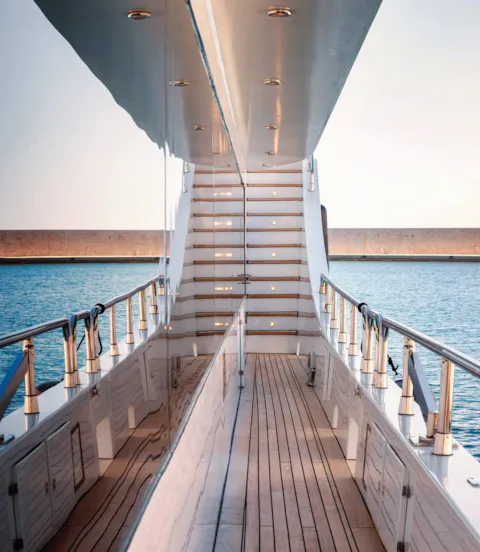A broader panorama
Bringing in the light, opening up panoramic views from inside the cabin — large glass elements fascinate designers and owners alike. DNV GL presents the class perspective on using glass in structural components.
Glass has for decades played a part in ship design, and over time the size of glass elements has increased considerably as new applications were introduced, such as glazed bulwarks and atriums. “DNV GL has broad experience with large glass element applications, going back to the Lürssen-built Rising Sun with its slim supports and full-height glass panels,” says Martin Richter, Ship Type Expert Yachts at DNV GL.
With the development of laminated glass there is increasing interest in using glass even as a structural element. Especially in recent years designers and shipyards have approached DNV GL intending to make greater use of glass as a structural element.

Key considerations for designers
DNV GL’s main focus as a classification society is to ensure safety and structural integrity. From a design perspective this means finding solutions in a way that statutory and class requirements are complied with, most importantly in terms of structural strength, watertight integrity and freeboard requirements.
It is the manner in which any particular glass element is to be integrated into the structure of a yacht that demands close cooperation, not just between the designer, the yard, the flag state and class, but also with the suppliers and manufacturers. This aspect is of vital importance in view of the specific properties of the glass intended to be used and the way it is integrated into the surrounding structure. “At the same time, keeping an open mind towards the designer’s vision as well as the owner’s wishes is essential — without compromising safety and structural integrity, of course,” states Richter.
One of the advantages of using glass as a structural element is the fact that it allows the designer to create an impression of open space. This brings natural light into the interior of the yacht in a way that has never been possible before. What is more, laminated glass is superior to monolithic glass in its ability to maintain integrity and weather-tightness even after sustaining damage.
“There are some trade-offs, however,” Richter states. The tensile strength of glass is comparatively low. Dependent on the loads, a similar structure made of glass rather than a more traditional material, such as steel, might consequently be heavier. In addition, when designing and constructing a yacht it is important to account for the stiffness of glass elements when surrounded by the remaining, more flexible hull structure of the vessel, and to pay increased attention to the structural response and bond design.
Furthermore, wherever glass is used as part of a fire-rated division, the glass elements must pass the relevant fire tests. Since it is generally the largest glass element in the structure that will have to be fire-tested, it might be challenging to find a test laboratory that can handle such a large glass element.

Structural glass on yachts
DNV GL sees a growing tendency of new yacht designs trying to incorporate large glass constructions that function as structural elements. “The number of enquiries received recently confirms this trend,” Richter observes. There is a clear intention among designers to push the envelope in yacht design.
In particular, increasing sizes and new materials for these elements are in vogue. A similar trend can be observed in the cruise industry where large open areas create amazing panoramic views for guests. Yacht designers are likewise looking to bring natural light into cabins and the superstructure. Curved glass elements are used to reinforce the design of the yacht, which will be enhanced by structural glass.
As far as the material itself is concerned, there is growing interest in products commonly referred to as “smart glass”. This means that sensors are embedded in the glass that can alert the crew to damage, or enable the material to change its colour to reduce glare or otherwise change the properties of the light entering the vessel. Stronger but lighter types of glass could also open up new options for using glass in a ship’s structure.
DNV GL is an active member of the ISO working group developing new standards for glass and has spent considerable amounts of time evaluating and discussing how it can, as a classification society, support designers and manufacturers in this area, and especially how lighter and safer glass structures could be designed and applied so they will meet statutory and class requirements while satisfying the expectations of all stakeholders. DNV GL experts are well-prepared to give advice and evaluate design concepts.